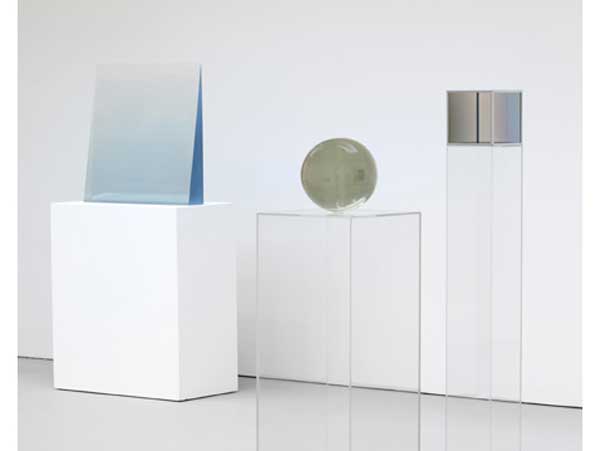-
Primary Atmospheres at David Zwirner
by Sarah Stephenson January 19, 2010

Bringing together the works of ten artists from the “Light and Space” movement, Primary Atmospheres: Works from California 1960-1970 at David Zwirner features artworks which all share a certain moment (1960′s L.A.) but also a very particular sensibility. Hollywood, West Coast landscapes and, in some cases, ruminations on the extraterrestrial (relevant at a time when UFO sightings were rife) – are all strong influences in works which, although artificial, investigate perceptual phenomena through their luminosity.
Contrary to the claim that it includes rarely seen works, a large number of the pieces on display here have been on view over the past couple of years at NYEHAUS (a solo exhibition with Laddie John Dill is currently on show here at the moment). However, none of these works have been shown together in this context for a number of years.
While certainly atmospheric, the works included in the first series of rooms are grouped so as to resemble various sci-fi set pieces. The ephemeral glow of Doug Wheeler’s light piece, Untitled (1969), beams like an ambient square sun eclipsed by the congested smog of a sprawling city; Robert Irwin’s almost invisible, acrylic sculptures initially give the impression of an optical glitch but then materialize into alien objects that seem to hover in space; while James Turrell’s colored projections form 3-dimensional prisms which are deceptively ‘real’ in the angular corners of the room.
Passing by Laddie John Dill’s sand environment – it’s difficult to linger as it’s located in the hallway – visitors encounter a mound of sand intersected by twelve glass panes. This artificial landscape resembles a terrarium which has been disassembled and reformed into a minimal, model seascape with glass breakwaters. Ominously emanating from the argon within the glass, green linear reflections suggest an inexplicable dimension which could easily pass unnoticed.

A temple-like arrangement of abstract artifacts dominates the next room, consisting of a series of Larry Bell’s reflective glass boxes and Helen Pashgian’s oval and spherical glass objects atop clear, Plexiglas plinths. They form a crooked aisle which leads to John McCracken’s esoteric Black Pyramid (1975) sculpture, in an altar-like position at the head of the room. Peter Alexander’s cast polyester resin Green Wedge (1969), adjacent to the aisle of artifacts, could easily be mistaken as a solid interpretation of Turrell’s Juke Green (1968) projection in the previous room. This underlying interest in the refraction of light and use of glass also reveals its influence later in the work of various artists such as Gerhard Richter and Jorge Pardo.
Instead of continuing with the sombre tone, the final room is especially playful with large sculptures in primary colors by John McCracken, Craig Kauffman and DeWain Valentine, a display seemingly better suited in an oversized, glossy playroom. The title of Valentine’s Triple Disk Red Metal Flake – Black Edge (1966) suggests a heavy-duty sculpture, but more closely resembles a bright red row of flying saucers. Craig Kauffman’s Plexiglas “bubbles,” resemble huge, colorful, rectangular pacifiers despite being molded using the same industrial technique developed for commercial signs.
The latest example of a gallery striving for museum-level exhibitions, Primary Atmospheres features loans from prominent institutions and collectors as well as an illustrated catalog complete with essay by Dave Hickey. We may wonder whether a more appropriate location would be an institution simply interested in exhibiting the work and curating the show a little less awkwardly. However, the exhibition does ultimately succeed in bringing together ephemeral artworks, collectively fascinated by the otherworldly, which question our human sensations at a time when, perhaps, we too are searching for the other.

